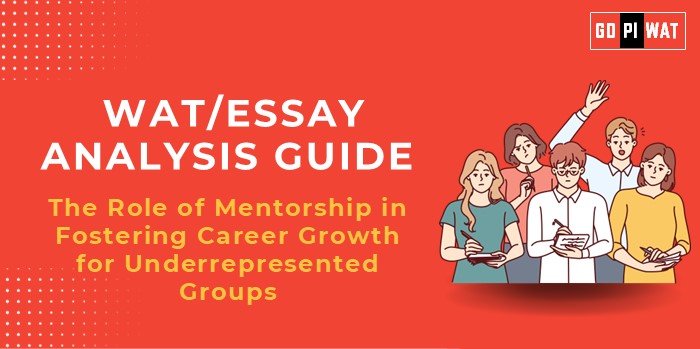📋 WAT/Essay Analysis Guide: The Role of Mentorship in Fostering Career Growth for Underrepresented Groups
🌐 Understanding the Role of Mentorship
Mentorship plays a pivotal role in addressing systemic career challenges faced by underrepresented groups. It directly connects to organizational diversity and inclusion goals, a key focus for business leaders.
📝 Effective Planning and Writing
- ⏳ Time Allocation: Planning (5 min), Writing (20 min), Review (5 min).
- 📚 Preparation Tips:
- 🔍 Use impactful statistics, stakeholders, and case studies to support arguments.
✨ Introduction Techniques for Essays
- 🔄 Contrast Approach: “Despite only 5% of Fortune 500 CEOs being minorities, structured mentorship programs have improved career growth opportunities for underrepresented groups.”
- 💡 Solution-Based Approach: “Mentorship is a powerful solution to bridge workplace diversity gaps, offering guidance, skills, and career sponsorship for marginalized groups.”
📚 Structuring the Essay Body
🌟 Paragraph 1: Achievements
- Highlight success stories like IBM and SAP’s global mentorship models.
- Use statistics: “Retention improved by 50% where mentorship programs are in place.”
⚠️ Paragraph 2: Challenges with Comparative Analysis
- Discuss access limitations and implicit bias.
- Example: “In SMEs, lack of resources inhibits formal mentorship programs.”
🌍 Paragraph 3: Future Outlook
- Recommend integrating mentorship with technology-driven platforms and sponsorship initiatives.
- Global perspective: “Adopting initiatives like Lean In Circles globally can create broader impacts.”
📄 Concluding Effectively
- ⚖️ Balanced Perspective: “While mentorship programs improve career growth for underrepresented groups, addressing systemic barriers through sponsorship and inclusive policies is equally important.”
- 🌐 Global Comparison: “Countries like the U.S. have pioneered mentorship initiatives, demonstrating that structured support systems can foster equitable career progression.”
📊 Analyzing Successes and Shortcomings
🏆 Key Achievements:
- Better retention.
- Leadership representation.
- Inclusive workplaces.
⚠️ Challenges:
- Resource gaps.
- Mentorship without sponsorship.
- Bias issues.
🌍 Global Context:
- Compare with successful programs in the U.S., Europe, and Asia.
🔑 Recommendations for Sustainable Progress
- 📊 Implement technology-driven platforms: AI mentorship tools for accessibility.
- 📜 Policy-driven incentives: Mandating formal mentorship programs in organizations.
- 🤝 Combine mentorship with sponsorship: Ensuring career advocacy alongside guidance.
📝 Sample Short Essays
⚖️ Balanced Perspective:
“Mentorship is instrumental for career growth among underrepresented groups. Programs like IBM’s global mentorship have increased retention by 50%. However, structural changes, like addressing access inequality and policy mandates, are essential for long-term impact.”
💡 Solution-Oriented:
“To address diversity gaps, mentorship programs offer skills, guidance, and sponsorship opportunities. Adopting global best practices and integrating technology-driven tools will create accessible, impactful mentorship.”
🌍 Global Comparison:
“While India’s leadership diversity remains limited, global mentorship programs like SAP and Lean In Circles demonstrate how structured guidance systems can foster equitable opportunities for career growth.”
This guide provides a comprehensive analysis for group discussions and essays, equipping B-school aspirants with structured arguments, impactful data, and real-world applications to address mentorship’s role in fostering career growth for underrepresented groups.


